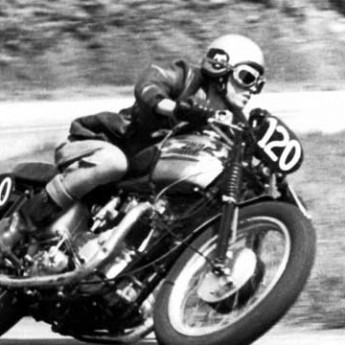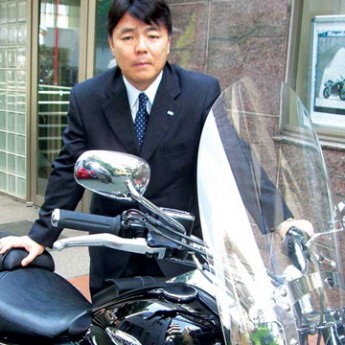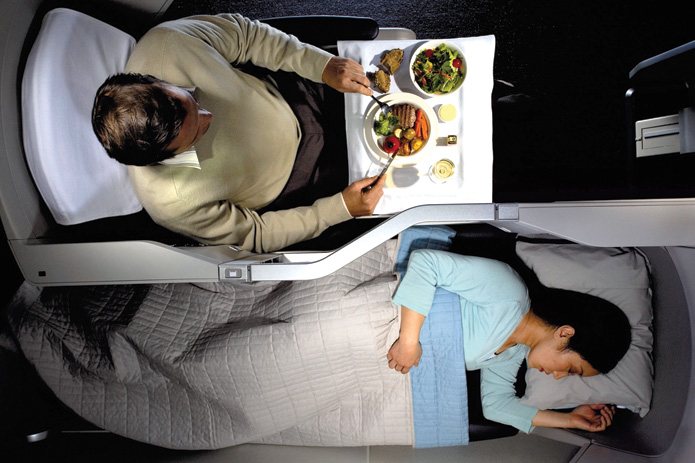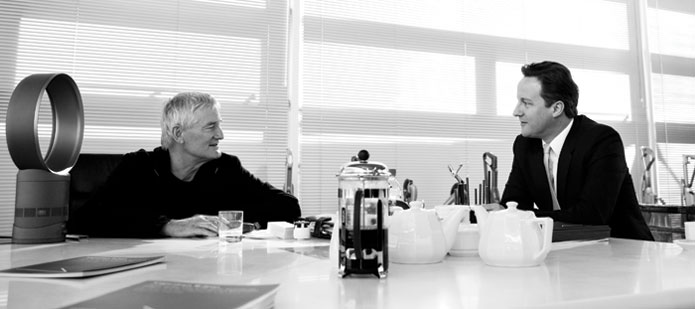There’s nothing quite like the rumbling, throaty growl of a Triumph as it kicks into life. In the country renowned for mass global motorbike production, the president of Triumph Japan says it is that reassuring feeling of power at the rider’s fingertips — and the heritage of the bike melded with modern technology — that sets apart the classic British marque.
“These motorcycles have a long history and we find that customers are really able to identify with the name, the brand” says Fumio Arai. “The product has an attractiveness that is distinct from that of any other bike on the road and there’s just a real pleasure in riding a Triumph.
“When you hear the sound of the vertical twin engine or the triple engine starting up, that’s a sexy sound that our competitors just can’t imitate”, he says.
Motorcycle enthusiasts apparently concur. Sales have risen impressively since Triumph’s debut in Japan. Introduced here in December 2000, sales first climbed in 2004 and reached 1,374 units in fiscal 2007 (which, for Triumph, runs from July to June). The year 2008 was the best on record, with numbers up more than 30% (1,762 units). Despite the global economic downturn, Triumph increased its annual turnover from ¥2 billion in 2008 to ¥2.05 billion in the latest reporting year.
Arai, an ambitious man, has set a challenging sales target of 2,000 units for 2010, and wants turnover to hit ¥2.5 billion.
With a staff of 12, a busy marketing team, and 44 Triumph dealers nationwide, Arai believes the key is raising brand profile, and this he has begun to do.
One way is the 9 October launch of the latest addition to the Triumph stable, the reborn and much-loved Thunderbird.
With a new double-overhead camshaft 1,597-cc engine and an antilock braking system as standard, this classic cruiser will go up against Harley-Davidson — although Arai points out that the British-built bike has a more modern engine and a more reasonable price than its US rival. Triumph sold 20 of the bikes on launch day alone.
“The average Triumph owner in Japan is 37 years old, but recently we have been seeing more younger people purchasing these bikes, as well as an increase in the number of women customers”, said Arai. “Women like the low seats and the stylish design of the bikes, while it is also a help that the retail price is so reasonable”
A Bonneville 865 vertical is ¥998,000 and the Scrambler costs ¥1.2 million. The most expensive Triumph bike sold in Japan is the
2.3-liter Rocket III — the world’s most powerful production motorcycle — but government fuel regulations caused imports to end.
That gap is being filled by new designs that will give local and foreign rivals a serious run for their money.
Triumph has teetered on the brink of extinction several times in its 107-year existence, but is now the world’s oldest-surviving motorcycle manufacturer.
The story begins when German immigrant Siegfried Bettman arrived in Coventry to import bicycles and sewing machines. In 1886, the Triumph Cycle Company was born, building its first bicycle in 1889.
Triumph branched out into motorcycles and, in 1902, put its first vehicle — albeit one designed by another company — on the road. By 1904, it was designing its own motorbikes and production was ramped up to 1,000 units at a new, purpose-built plant in 1907.
WWl was a boom period for Triumph, as it supplied vehicles to the military. By the mid-1920s, it had evolved into one of Britain’s leading manufacturers of motorcycles and cars, turning out 30,000 a year. The 1930s’ Great Depression hit the company hard, and the motorcycle and car units were separated; the bike unit fared better and stepped up efforts to increase sales in overseas markets.
Badly damaged by German bombs during WWll, Triumph shifted production in 1942 to the West Midlands. After the war, 70 percent of production was being sold abroad, including the Triumph Speed Twin and Triumph Tiger 100.
To meet US demand for touring motorbikes, the company designed a 650-cc version of the Speed Twin, set to become the first Triumph Thunderbird. The company attracted even greater attention across the Atlantic when Marlon Brando sat astride a 1950 Thunderbird in the film The Wild One.
Another icon, the Bonneville, was born in 1959 as a tuned, double-carburettor version of the earlier Tiger T110. A decade later, a Bonneville ridden by Malcolm Uphill won the Isle of Man Production TT at an average speed of 99.99mph.
In the same year, Triumph controlled half of the US market for bikes over 500cc, but couldn’t keep up with the technological advances, primarily of Japanese firms. As Triumph fought Far Eastern competition, the arrival in large numbers of Honda, Suzuki, Yamaha and Kawasaki machines ended the company’s domination.
Buyouts and failures with various partners ensued until Triumph went into receivership in 1983. Rather than see it disappear, motorcycle enthusiast John Bloor bought the name and manufacturing rights from the Official Receiver and set up Triumph Motorcycles (Hinckley) Ltd.
The new outfit started very slowly — in the first five years of production a mere 14 bikes were made weekly — although the designers were quietly monitoring the competition and designing prototype models.
Operating from a state-of-the-art factory in Hinckley, Leicestershire, Triumph in 1991 unveiled a new range of bikes. These ranged from 750-cc and 900-cc triple-cylinder units to 1,200-cc four-cylinder bikes. After the inevitable teething problems, domestic and overseas sales picked up.
As Triumph prepared to celebrate its centenary, tragedy struck. In March 2002, a blaze destroyed its main factory, despite the efforts of more than 100 firefighters. But within six months, the premises had been rebuilt and were back in full production.
[greybox]A rough ride
Triumph has teetered on the brink of extinction several times in its 107-year existence, but is now the world’s oldest-surviving motorcycle manufacturer.
The story begins when German immigrant Siegfried Bettman arrived in Coventry to import bicycles and sewing machines. In 1886, the Triumph Cycle Company was born, building its first bicycle in 1889.
Triumph branched out into motorcycles and, in 1902, put its first vehicle — albeit one designed by another company — on the road. By 1904, it was designing its own motorbikes and production was ramped up to 1,000 units at a new, purpose-built plant in 1907.
WWl was a boom period for Triumph, as it supplied vehicles to the military. By the mid-1920s, it had evolved into one of Britain’s leading manufacturers of motorcycles and cars, turning out 30,000 a year. The 1930s’ Great Depression hit the company hard, and the motorcycle and car units were separated; the bike unit fared better and stepped up efforts to increase sales in overseas markets.
Badly damaged by German bombs during WWll, Triumph shifted production in 1942 to the West Midlands. After the war, 70 percent of production was being sold abroad, including the Triumph Speed Twin and Triumph Tiger 100.
To meet US demand for touring motorbikes, the company designed a 650-cc version of the Speed Twin, set to become the first Triumph Thunderbird. The company attracted even greater attention across the Atlantic when Marlon Brando sat astride a 1950 Thunderbird in the film The Wild One.
Another icon, the Bonneville, was born in 1959 as a tuned, double-carburettor version of the earlier Tiger T110. A decade later, a Bonneville ridden by Malcolm Uphill won the Isle of Man Production TT at an average speed of 99.99mph.
In the same year, Triumph controlled half of the US market for bikes over 500cc, but couldn’t keep up with the technological advances, primarily of Japanese firms. As Triumph fought Far Eastern competition, the arrival in large numbers of Honda, Suzuki, Yamaha and Kawasaki machines ended the company’s domination.
Buyouts and failures with various partners ensued until Triumph went into receivership in 1983. Rather than see it disappear, motorcycle enthusiast John Bloor bought the name and manufacturing rights from the Official Receiver and set up Triumph Motorcycles (Hinckley) Ltd.
The new outfit started very slowly — in the first five years of production a mere 14 bikes were made weekly — although the designers were quietly monitoring the competition and designing prototype models.
Operating from a state-of-the-art factory in Hinckley, Leicestershire, Triumph in 1991 unveiled a new range of bikes. These ranged from 750-cc and 900-cc triple-cylinder units to 1,200-cc four-cylinder bikes. After the inevitable teething problems, domestic and overseas sales picked up.
As Triumph prepared to celebrate its centenary, tragedy struck. In March 2002, a blaze destroyed its main factory, despite the efforts of more than 100 firefighters. But within six months, the premises had been rebuilt and were back in full production.[/greybox]










